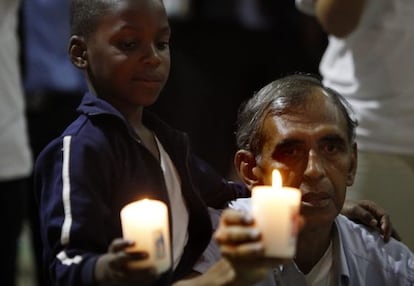Impunity in murder cases is growing in Latin America, UN warns in report
Police and justice systems are not capable of dealing with “saturation of cases”


Soaring murder rates and impunity continue to be the Achilles heel that is keeping Latin America from enjoying steady development, according to the United Nations.
In its “2013 Global Study on Homicide,” which was presented in London last week, the UN Office on Drugs and Crime (UNODC) said that there have been drops in the murder conviction rates in recent years throughout the region. In Latin America, the conviction rate is 24 people for every 100 murders that take place; in Asia, it is 48 per 100, while in Europe it is 81 for every 100 persons.
“The level of impunity for homicide in the Americas is thus rather high, which may be partly due to the fact that the region’s high intensity of homicide is a drain on criminal justice resources,” according to the study.
At a news conference in Mexico City on Thursday, Antonio Mazzitelli, the UNODC officer for the region, blamed it on the “saturation of cases” throughout Latin America.
“The police and the judicial systems don’t have the capacity to carry out serious investigations or trials,” he said.
In 2012, there were more murders committed in the Americas, including the United States and Canada, than in any other continent. Of the global total of homicides that occurred that year, 36 percent – or about 157,000 violent deaths – took place in the region.
“Colombia’s homicide rate has been decreasing since 1996 but remains at a very high level, while the Bolivarian Republic of Venezuela is the only country in South America that has had a consistently increasing homicide rate since 1995,” the report said.
In 2012, more murders were committed in the Americas than in any other continent, according to the report
Africa ranked second with 31 percent of the world total followed by Asia with 28 percent. Europe placed next with five percent and Oceania at 0.3 percent.
“The global average homicide rate stands at 6.2 per 100,000 population, but Southern Africa and Central America have rates over four times higher than that (above 24 victims per 100,000 population), making them the sub-regions with the highest homicide rates on record, followed by South America, Middle Africa and the Caribbean (between 16 and 23 homicides per 100,000 population)”, the study said.
Most of the murders that occur in the Americas are related to organized crime and drugs (30 percent) compared to the less than one percent that take place in Asia and Europe. “This does not mean that the organized crime and gangs can be predominately found in the Americas,” the report said.
Mazzitelli gave his own personal experiences of growing up in Italy. “I came from the south of Italy where the ‘Ndrangheta [local mafia clan] controls the region, and when one group controls the entire territory not many murders take place. It is the battle for control of a territory between different groups that generates the most homicides. One factor contributing to a lower crime rate is the presence of state institutions and authority.”
The UN representative, who has been stationed in Mexico for the past four years, also discussed some of the region’s hot spots.
He called the recent truce signed between the maras street gangs in El Salvador “a positive step.” “Anything to reduce murder rates and situations that provoke violence and replace them with social inclusion programs is a good thing.”
Asked about the self-defense forces in Mexico’s violent Michoacán state, Mazzitelli said: “I think many in the vigilante groups want to demobilize, but they will do so only if there is a real commitment by the state to maintain safety and promote development for the region.”
Tu suscripción se está usando en otro dispositivo
¿Quieres añadir otro usuario a tu suscripción?
Si continúas leyendo en este dispositivo, no se podrá leer en el otro.
FlechaTu suscripción se está usando en otro dispositivo y solo puedes acceder a EL PAÍS desde un dispositivo a la vez.
Si quieres compartir tu cuenta, cambia tu suscripción a la modalidad Premium, así podrás añadir otro usuario. Cada uno accederá con su propia cuenta de email, lo que os permitirá personalizar vuestra experiencia en EL PAÍS.
¿Tienes una suscripción de empresa? Accede aquí para contratar más cuentas.
En el caso de no saber quién está usando tu cuenta, te recomendamos cambiar tu contraseña aquí.
Si decides continuar compartiendo tu cuenta, este mensaje se mostrará en tu dispositivo y en el de la otra persona que está usando tu cuenta de forma indefinida, afectando a tu experiencia de lectura. Puedes consultar aquí los términos y condiciones de la suscripción digital.
Últimas noticias
Maduro pleads not guilty before the federal court in New York: ‘I am still the president of Venezuela’
A new test can detect Alzheimer’s from a finger prick
UN team enters Sudanese city of El Fasher after paramilitary massacre: ‘It’s like a ghost town’
A recipe for resistance: Indigenous peoples politicize their struggles from the kitchen
Most viewed
- Gilles Lipovetsky: ‘If you want to live better and fall in love, take Prozac, don’t look to philosophy’
- Alain Aspect, Nobel laureate in physics: ‘Einstein was so smart that he would have had to recognize quantum entanglement’
- Maduro’s downfall puts China’s relationship with Venezuela to the test
- Why oil has been at the center of Venezuela-US conflicts for decades
- Alvin Hellerstein, a 92-year-old judge appointed by Bill Clinton, to preside over Maduro’s trial in New York








































